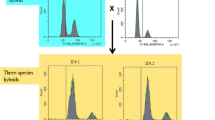Abstract
In this work, the studies on the previously detected phenomenon of concealed heterokaryosis in Saccharomyces cerevisiaewere continued. In genetic and Southern blotting experiments, one of the nuclei in the heterokaryon was shown to be active (capable of division and ensuring the corresponding cell phenotype), whereas the other was not expressed until the heterokaryotic clone was transferred to the medium selective for this concealed nucleus. Moreover, the concealed nucleus was able to assume the active state after fusion with the second parental nucleus. It was analyzed whether the nuclei with new marker combinations occurring in meiosis can behave as exceptional nuclei. Tetrad analysis of hybrids carrying the kar1mutation in their nuclei revealed the relatively high percentage of exceptional tetrads (more than 10%). One spore in these tetrads usually formed diploid cells capable of sporulation. The presented data of genetic and molecular biological studies testify in favor of the assumption that abnormal spores contain two nuclei, which form an “illegitimate” hybrid after fusion. An extraneous nucleus (termed x) has usually a genotype close to that of one of the spores in this tetrad. Thus, it was assumed that the additional DNA replication round occurs in the absence of cell division during one of meiotic divisions. Results of cytological analysis conducted by the method of specific DNA staining confirmed the existence of exceptional tetrads, one spore of which contains two nuclei.
Similar content being viewed by others
REFERENCES
Nevzglyadova, O.V., Davydenko, S.G., Smirnova, T.I., and Soidla, T.R., Concealed Heterokaryons in Saccharomyces cerevisiae Strains: Pseudopleiotropic Suppression in Strain YPH857 Carrying Multiple Markers, Genetika (Moscow), 1998, vol. 34, no. 12, pp. 1597-1602.
Nevzglyadova, O.V., Davydenko, S.G., Smirnova, T.I., and Soidla, T.R., Concealed Heterokaryons in Saccharomyces cerevisiae Strains: Model Experiments, Genetika (Moscow), 1998, vol. 34, no. 12, pp. 1603-1609.
Nevzglyadova, O.V., Smirnova, T.I., Gaivoronskii, A.A., and Soidla, T.R., Concealed Heterokaryons in Saccharomyces cerevisiae Strains: Prerequisites to Manifestation of a Cryptic Heterokaryon, Genetika (Moscow), 2000, vol. 36, no. 8, pp. 1017-1024.
Wright, R.E. and Lederberg, J., Extranuclear Transmission in Yeast Heterokaryons, Proc. Natl. Acad. Sci. USA, 1957, vol. 43, pp. 919-923.
Sikroski, R.S. and Hieter, P., A System of Shuttle Vectors and Yeast Host Strains Designed for Efficient Manipulation of DNA in Saccharomyces cerevisiae, Genetics, 1989, vol. 122, pp. 19-27.
Sherman, F., Fink, G.R., and Hicks, J.B., Laboratory Course Manual for Methods in Yeast Genetics, Cold Spring Harbor, New York: Cold Spring Harbor Lab., 1986.
Sambrook, J., Fritsch, E.F., and Maniatis, T., Molecular Cloning: A Laboratory Manual, Cold Spring Harbor, New York: Cold Spring Harbor. Lab., 1989.
Gebeyehu, G., Rao, P.Y., and Chan, P.S., Novel Biotinylated Nucleotide Analogs for Labeling and Colorimetric Detection of DNA, Nucleic Acids Res., 1987, vol. 15, no. 11, pp. 4513-4534.
Author information
Authors and Affiliations
Rights and permissions
About this article
Cite this article
Nevzglyadova, O.V., Gaivoronskii, A.A., Artemov, A.V. et al. Detection of Concealed “Illegitimate” Nuclei in Tetrad Analysis of the Diploid Progeny of Heterokaryons in Saccharomyces cerevisiae. Russian Journal of Genetics 37, 617–623 (2001). https://doi.org/10.1023/A:1016665022488
Issue Date:
DOI: https://doi.org/10.1023/A:1016665022488




